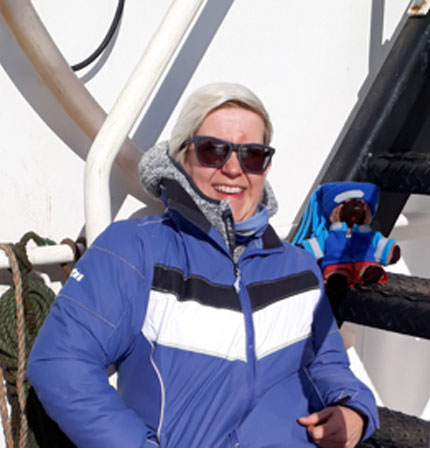My role at SAMS
I am a research assistant at SAMS, focusing mainly on marine phytoplankton taxonomy and microbial dynamics. My specialist field is in the identification of a select group of flagellates called Choanoflagellates. Normally my work involves analysis of marine water samples from around the world, identifying and enumerating bacteria and phytoplankton and calculating their biomass within the sampled waters. Population numbers and biomass can then be related to the carbon and nitrogen cycling as well as physical ocean dynamics. Over the years I have become more focused on Arctic phytoplankton and the effects of climate change and ocean acidification on their community structure.
I have a variety of skills which I have developed through my time at SAMS including microscopy (including inverted, confocal and electron microscopy), flow-cytometry, algal culturing and radio-isotope analysis for both bacterial and primary production.
As a research assistant I manage three support scientists ensuring their outputs are successful and I see that their development needs are met.
I am a laboratory manager for three areas: histology, microscopy and electron microscopy. This involves running efficient labs that meet all the health and safety requirements.
I assist with a variety of commercial contracts and I also take part in our outreach programme with local schools and events to promote SAMS science and inspire the next generation of scientists.
I spend part of my time working in the field, occasionally at research stations but mostly at sea on research ships. The field work is usually based locally but every few years I get to work out in the open ocean, mostly the Celtic sea, Atlantic and the Arctic oceans.
Current research projects
ArcticPRIZE - Arctic
DIAPOD - Arctic
SAICHATCH - algal culturing
FSA - commercial monitoring contract
Current teaching commitments
Marine Science BSc: Year 1 practical on 'Phytoplankton collection and identification'
Marine Science BSc: Year 3 practical on 'Protozoan feeding experiments'
Marine Science BSc: Year 4 practical in the use of flow cytometry
I also assist with occasional teaching on short courses and postgraduate programes
Fieldwork experience
Local Sampling - Sampling on SAMS boats for a variety of projects - ongoing
JCR 006 2017 – Barents Sea cruise, primary production experiments and routine sampling to complement primary production data including POC, Chlorophyll.a, DOC, DOP, flow cytometry, phytoplankton and coccolithophore samples
Discovery 2015 - CANDYFLOSS cruise DY029. Bacterial production, DOC & MSC routine sampling for bacterial and pico abundances
JCR 2012 - Ocean Acidification cruise JR271. Arctic leg: Bacterial abundance measurements via flow cytometry for standard samples and OA experiments
JCR 2010 - Second Ice chaser cruise JR219 – Bacterial abundance by flow cytometry, DOC & DOM experiments, phytoplankton sampling, Viral Lysogeny/Lysis experiments. Analysis of all samples
JCR 2008 - First Ice chaser cruise JR210– Bacterial abundance by flow cytometry, DOC & DOM experiments, phytoplankton sampling. Assist with bacterial production experiments. Analysis of all samples
Norway 2003 - Trondheim research station. Mesocosom experiments. Bacterial and pico abundances by microscopy, DOC & DOM experiments.
Orkney A, Davidson K, Mitchell E, Henley SF and Bouman HA (2022) Different Observational Methods and the Detection of Seasonal and Atlantic Influence Upon Phytoplankton Communities in the Western Barents Sea. Front. Mar. Sci. 9:860773. https://doi.org/10.3389/fmars.2022.860773
García-Martín, EE, Daniels, CJ, Davidson, K, Lozano, J, Mayers, KMJ, McNeill, S, Mitchell, E, Poulton, AJ, Purdie, DA, Tarran, GA, Whyte, C, Robinson, C (2017) Plankton community respiration and bacterial metabolism in a North Atlantic Shelf Sea during spring bloom development (April 2015). Progress in Oceanography. https://doi.org/10.1016/j.pocean.2017.11.002
Grigorios Moschonas, Richard J. Gowen, Ruth F. Paterson, Elaine Mitchell, Brian M. Stewart, Sharon McNeill, Patricia M. Glibert, Keith Davidson (2017) ‘Nitrogen dynamics and phytoplankton community structure: the role of organic nutrients’ Biogeochemistry, Vol 134 125-145
GA Tarling, V Peck, P Ward, NS Ensor, E Achterberg, E Tynan, AJ Poulton, E Mitchell and MV Zubkov,(2016) ’Effects of acute ocean acidification on spatially-diverse polar pelagic foodwebs: insights from on-deck microcosms’, Deep-Sea Research Part II, http://dx.doi.org/10.1016/j.dsr2.2016.02.008
Whyte.C et al (2016) ‘Tracking changes to a microplankton community in a North Atlantic loch using the microplankton index PI(mp) ICES Journal of Marine Science
Moigne,F.A.C, et al (2015) ‘Carbon Export efficiency and phytoplankton community composition in the Atlantic sector of the Arctic Ocean’ Journal of Geophysical Research:Oceans 120, 3896-3912
Fouilland.E, Le Floch.E, Brennan.D, Lordsmith.S.L, McNeil.S, Mitchell.E, Brand.T.D, Garcia-Martin.E.E and Leakey.R.J.G. (in progress) ‘Microbial carbon and Nitrogen cycling in Arctic waters: Evidence for low carbon-coupling and high competition for nitrogen between phytoplankton and bacteria.’
K.Davidson, L.C.Gilpin, M.Hart, E.Fouilland, E.Mitchell, I.Alvarez Calleja, C.Laurent, A.E.J.Miller and R.J.G.Leakey (2007) ‘The influence of the balance of inorganic and organic nitrogen on the trophic dynamics of microbial food webs’ Journal of Limnology and Oceanography. 52(5) 2147-2163
K.Davidson, E.C.Roberts, A.M.Wilson, E.Mitchell (2005) ‘The role of prey nutritional status in governing protozoan nitrogen regeneration efficiency.’ Journal of Protistology Vol.156
R.J.G Leakey, B.S.C Leadbeater, Elaine Mitchell, Sharon M.M McCready and Alistair W.A Murray (2002) ‘The abundance and biomass of choanoflagellates and other nanoflagellates in waters of contrasting temperature to the north-west of South Georgia in the Southern Ocean.’ Europ.J. Protistol. 38, 333-350.
Employment history
Since 2015 Research Assistant. SAMS
2002-15. Support Scientist. SAMS
1998-2002 Microbial Laboratory Technician. Thames Water
Qualifications
1997 BSc (Hons) Biology and Geography. Coventry University
